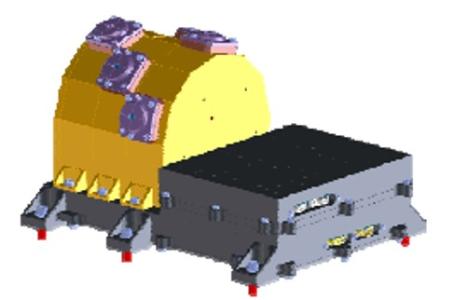3D Energetic Electron Spectrometer Phases C and D
Programme
GSTP
Programme Reference
G618-011EE
Prime Contractor
QINETIQ SPACE NV
Start Date
End Date
Status
Closed
Country
Belgium

Objectives
To complete the development of the novel 3-d directional electron spectrometer (3DEES) designed in phase A/B. Directional measurements, when used together with basic physical principles of the radiation belts, can be used to construct a full map of the radiation belts. Phase C1 will perform enabling developments foreseen in phase A/B and complete the instrument detailed design. In particular the molded stack to house sensors will be developed and tested in this phase. C2 will manufacture, test and calibrate an EM with the potential to be flown on a demonstration flight. D will manufacture a PFM using space qualified components aimed at providing a high-quality instrument for an operational flight.
Description
The 3DEES design established in the previous activity has multiple sensor stacks, each sampling a different direction. The detection techniques build on the technology from the general-purpose Energetic Particle Telescope (EPT) that is flying on Proba-V. To provide mechanical stability, low mass and compactness, a molded epoxy stack will hold both sensors and front-end electronics.
In particular the following development will be done in each of the phases:
Phase C1 (1,500K?), updated detailed design, updated development plan, prototype mechanical ground support equipment (MGSE):
- One demonstrator molded sensor stack will be manufactured. The stack will contain 4 sensors, an absorber and FEE boards. Particle detection tests will be performed on the stack, including sensors, FEE and a dedicated housing, to ensure noise is within acceptable limits. Preliminary design and prototyping of the MGSE to be used in vacuum will be performed. Based on lessons learned from the stack development and testing in this phase, the detailed design of the instrument shall be completed and the development plan from phase A/B shall be updated.
Phase C2 (1,000 K?), flyable EM, test and calibration data.
- The manufacture, calibration and testing of an engineering model (EM) of one 6-directional Panoramic Spectrometer Module (PSM) will be performed. Although this EM will not be built using methods and components that are fully space qualified it will be tested and handled in a way that makes it possible to be flown on a demonstration flight. For this, qualified spacecraft interfaces will be included, as well as FM detectors. The aim and expectation for such a flight is that high-quality data environment data would be generated although there would be no guarantee on the life expectancy of the instrument.
Phase D (1,300 K?), FM, test and calibration data
- In this phase 2 PSMs (allowing 12 look directions in 2 orthogonal planes) will be manufactured using space qualified techniques and components, to be flown for Space Weather or science purposes.;
Application Domain
Space Safety
Technology Domain
4 - Space Systems Environments and Effects
Competence Domain
10-Astrodynamics, Space Debris and Space Environment
Keywords
0-Space Situational Awareness
Initial TRL
TRL 3
Target TRL
TRL 7
Public Document
